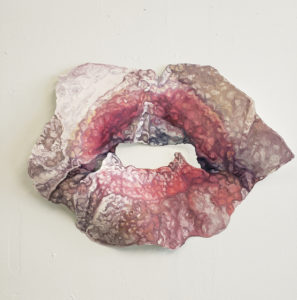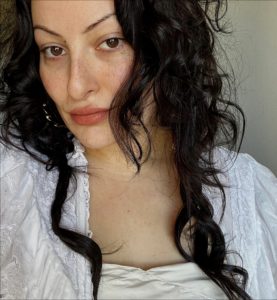New Art Writing by Kyra Lambert, on the work of Riisa Gundesen
Interview available in LARGE FONT
In conversation with Riisa Gundesen: ‘Toilettes’
by Kyra Lambert
Riisa Gundesen’s exhibition ‘Toilettes’ begins at the Eastern Edge Gallery on March 10th and will run until April 22nd. Gundesen’s work swirls around themes of femininity, experiences with anxiety and depression and in ‘Toilettes’ specifically, the rituals of gendered performance in the artist’s bathroom. I called Riisa in her studio during a busy day of work for a conversation about her upcoming exhibition at Eastern Edge. We started our conversation discussing our respective weather struggles, immediately clarified our name pronunciations and then launched into discussing her new exhibition, ‘Toilettes’.
K.L – When you were starting to design the composition of this exhibition, what particular personal routines did you want to highlight and why did they feel important?
R.G – I went into it initially thinking in terms of the space of the bathroom and the sensations, feelings and rituals that I might associate with the bathroom. I started with the items, then worked backwards towards the idea of ritual and action. I started with the facemask and thinking about lounging, relaxing and reclining, then getting into other elements like bath bombs, makeup sponges and kind of thinking of elements of grooming implied by the objects. I think I was thinking too, about ritual; I was conceiving of them a bit as they might have more than one implication, depending on if you have familiarity with that object or not. So I’m sort of depicting myself wearing incongruous things, that could be the intended use of the object but not necessarily. It’s a suggestiveness without putting too fine a point on exactly what’s going on within the ritual. Once I got into it, I was thinking about growing up and sneaking into my mom’s bathroom and looking at all her stuff; the potions, the instruments she had in there and this sense of “Oh, what does that do?” and it felt arcane and mysterious.
K.L – My mom had that medicine cabinet too; sparkly things, products that smelled and were powdery. It often felt like performing witchcraft and spell work in the bathroom space, so much curiosity about the tools for beauty!
R.G – My mother is an intensely pragmatic and practical person and she had this sense of second wave feminism. So there was never necessarily a desire on her part to transmit that kind of knowledge because she didn’t want us to be forced into that, I suppose. So there’s an element of mysteriousness and ambiguity that I’m sort of focusing on, and those childhood sensations.
K.L – So where would you say you found your ritual influences? For your own practices within the bathroom?
R.G – Probably more socially, you do what your friends are doing. There’s sort of a playfulness, I suppose, too; buying the products, trying them out, figuring out what’s interesting, what you like… Maybe for me, that playfulness and messing around is more appealing than actually using them within a routine.
K.L – The tactile experience of different products is really important. Is that something that you bring in?
R.G – There’s a sort of preciousness of the objects and the sensations. The colour I’m very interested in, which is probably very natural for a painter. I think too, with a lot of this work, a lot of these objects I wouldn’t have bought them, had it not been for the still life or the costuming. So there’s definitely this element of non-natural performance, where I’m setting up things, playing with things- that if it was just for myself I wouldn’t have necessarily interacted with them.
K.L – That actually dovetails really nicely into my next question. How do you relate to increased commodification of the private grooming routine in recent years? I feel like it’s really ramped up in the last few years with “GRWM” (Get ready with me) videos or product hauls for beauty and wellness. I’m really curious how that plays with your work.
R.G – Yeah, even before this body of work – which is bathroom centric. I was definitely engaging with self portraiture prior to this and thinking about the – going back to the old trope of depicting, in Western painting canon – the nude at her toilette. Whether that subject is the goddess, or Suzanna, the elders or Ophelia. It’s that image of the nude getting ready.
It’s this expectation of performance even in a private space, this ongoing performance, and it relates to contemporary media, social media and selfies. Recently, yeah, there’s a narrowing of that focus towards actively performing successful femininity or successful style. I don’t know – I think there’s something kind of fun and engaging with these types of imagery and playing – certainly there’s also an element that feels kind of like conspicuous consumption that feels gross.
I do feel like there’s something sinister about that because it feels tied to this massive oppressive and exploitative industry of beauty and fashion. On the other hand too, in terms of the people who make the videos themselves, it kind of falls under the category of “no ethical consumption under capitalism”. I don’t know if there’s anything particularly wrong or worse, about them showing off what they’re doing, instead of doing it anyway and not showing it.
K.L – It also made me think, you said, ‘the nude getting ready’, so the commodification of a woman in a private grooming space. Which was typically financially and socially benefitting the man artist, not the subject, and so now it’s kind of an interesting flip in that these content creators are running their own show, running their own finances and capital, but the ability to retain privacy within “self care” has definitely changed.
R.G – Maybe the reason it seems natural for these rituals to become public is because the assumption was always there that they were being performative anyways, so it seems natural that they became literal performance.
K.L – Is there any part of the gendered performance that feels exciting or honest in your own personal practice?
R.G – Yeah, it’s things I think would be aesthetically interesting to show and not necessarily do for myself. But I don’t know, there’s an honesty in the way the costumes are assembled, the way the still life is depicted; there’s some humorousness to it that I think is closer to honesty, the playfulness. There’s also, on the other side, the element of doing things with the figures that are not necessarily nice. There’s these really overworked areas, there’s elements of the abject grotesque within the body that relate to other sensations I associate with the bathroom.
I’ve had issues with having panic attacks specifically in that space. When I was a teenager and first starting to wear makeup, I had a lot of skin picking issues. And so it’s this ritualised picking and squeezing, and then you put the makeup on and that feels thick and heavy. These strange scratchy and greasy sensations, which I’m trying to get at with the way I treat the skin. I suppose that, yeah, there’s an honesty in the sensation I’m trying to portray there.
K.L – I feel like as a teen especially coming into changing skin and new textures emerging, skin-picking is so common especially as a manifestation of anxiety, so to have that translated onto a painting that people can relate to and see and interact with, feels really exciting.
R.G – The initial sensation I was after with these overworked areas of flesh, or just the skin was kind of, yeah, a clench in the gut; that confrontation with something gross, so that translation of sensation. They look at my body, ‘They’ being the viewer, have to feel their own body and it promotes that sort of bodily awareness.
K.L – I really like the way you’re able to marry traditional ideas of femininity that typically circulate around performing, and not being gross, not being icky – but you’re able to bring the opposite end
together in a much more realistic experience of having a body and happening to perform femininity.
R.G – I was definitely after those polar opposites, to get the sublime and the abject occupying those opposite poles. There’s a fascination with both the sublime and the grotesque that I think there’s actually some crossover, and some interest to bring them together.
K.L – What ideas would you like guests to hold space for when they enter into the exhibition?
R.G – What I’m most interested in, in terms of when people see the work for the first time, is to go back to sensation. Consider the feeling, the initial feeling – whether it’s sensational or emotional – that they feel when they first see the work.
I’m interested in the different interpretations depending on people’s experience with the types of objects, spaces and rituals that are described. I’m interested in the different reactions based on their familiarity or unfamiliarity with the kind of experiences I’m showing.
Kyra Lambert is a multidisciplinary artist whose works circulate around ideas of femininity, divinity and worship and take the form of jewellery, poetry and oil paintings. Lambert designs under the name ‘Sacred Grotto’. With strong roots in Pagan practice, Kyra’s work is emblematic of times past and the ocean’s offerings. Lambert is currently based in Halifax, NS and has received an emerging artist designation from the Canadian Council for the Arts.

